2011 INFINITI QX56 ECU
[x] Cancel search: ECUPage 3035 of 5598
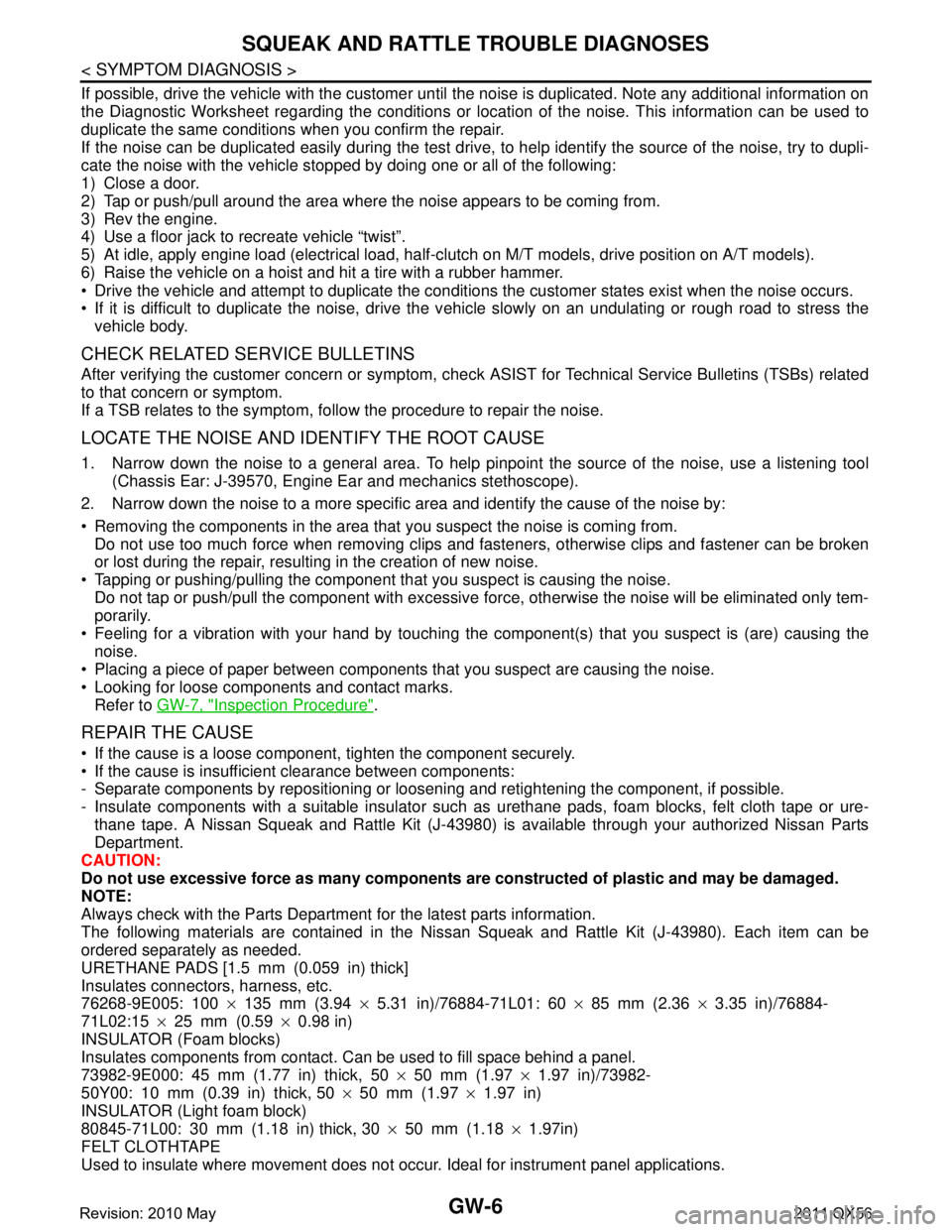
GW-6
< SYMPTOM DIAGNOSIS >
SQUEAK AND RATTLE TROUBLE DIAGNOSES
If possible, drive the vehicle with the customer until the noise is duplicated. Note any additional information on
the Diagnostic Worksheet regarding the conditions or lo cation of the noise. This information can be used to
duplicate the same conditions when you confirm the repair.
If the noise can be duplicated easily during the test drive, to help identify the source of the noise, try to dupli-
cate the noise with the vehicle stopped by doing one or all of the following:
1) Close a door.
2) Tap or push/pull around the area where the noise appears to be coming from.
3) Rev the engine.
4) Use a floor jack to recreate vehicle “twist”.
5) At idle, apply engine load (electrical load, half-cl utch on M/T models, drive position on A/T models).
6) Raise the vehicle on a hoist and hit a tire with a rubber hammer.
Drive the vehicle and attempt to duplicate the conditions the customer states exist when the noise occurs.
If it is difficult to duplicate the noise, drive the v ehicle slowly on an undulating or rough road to stress the
vehicle body.
CHECK RELATED SERVICE BULLETINS
After verifying the customer concern or symptom, chec k ASIST for Technical Service Bulletins (TSBs) related
to that concern or symptom.
If a TSB relates to the symptom, follo w the procedure to repair the noise.
LOCATE THE NOISE AND IDENTIFY THE ROOT CAUSE
1. Narrow down the noise to a general area. To help pi npoint the source of the noise, use a listening tool
(Chassis Ear: J-39570, Engine Ear and mechanics stethoscope).
2. Narrow down the noise to a more specific area and identify the cause of the noise by:
Removing the components in the area that you suspect the noise is coming from.
Do not use too much force when removing clips and fasteners, otherwise clips and fastener can be broken
or lost during the repair, resulting in the creation of new noise.
Tapping or pushing/pulling the component that you suspect is causing the noise.
Do not tap or push/pull the component with excessive force, otherwise the noise will be eliminated only tem-
porarily.
Feeling for a vibration with your hand by touching the component(s) that you suspect is (are) causing the
noise.
Placing a piece of paper between components that you suspect are causing the noise.
Looking for loose components and contact marks. Refer to GW-7, "
Inspection Procedure".
REPAIR THE CAUSE
If the cause is a loose component, tighten the component securely.
If the cause is insufficient clearance between components:
- Separate components by repositioning or loos ening and retightening the component, if possible.
- Insulate components with a suitable insulator such as urethane pads, foam blocks, felt cloth tape or ure-
thane tape. A Nissan Squeak and Rattle Kit (J-43980) is available through your authorized Nissan Parts
Department.
CAUTION:
Do not use excessive force as many components are constructed of plastic and may be damaged.
NOTE:
Always check with the Parts Departm ent for the latest parts information.
The following materials are contained in the Nissan Squeak and Rattle Kit (J-43980). Each item can be
ordered separately as needed.
URETHANE PADS [1.5 mm (0.059 in) thick]
Insulates connectors, harness, etc.
76268-9E005: 100 ×135 mm (3.94 ×5.31 in)/76884-71L01: 60 ×85 mm (2.36 ×3.35 in)/76884-
71L02:15 ×25 mm (0.59 ×0.98 in)
INSULATOR (Foam blocks)
Insulates components from contact. Can be used to fill space behind a panel.
73982-9E000: 45 mm (1.77 in) thick, 50 ×50 mm (1.97 ×1.97 in)/73982-
50Y00: 10 mm (0.39 in) thick, 50 ×50 mm (1.97 ×1.97 in)
INSULATOR (Light foam block)
80845-71L00: 30 mm (1.18 in) thick, 30 ×50 mm (1.18 ×1.97in)
FELT CLOTHTAPE
Used to insulate where movement does not occu r. Ideal for instrument panel applications.
Revision: 2010 May2011 QX56
Page 3037 of 5598

GW-8
< SYMPTOM DIAGNOSIS >
SQUEAK AND RATTLE TROUBLE DIAGNOSES
3. The trunk lid torsion bars knocking together
4. A loose license plate or bracket
Most of these incidents can be repaired by adjusting, securing or insulatingthe item(s) or component(s) caus-
ing the noise.
SUNROOF/HEADLINING
Noises in the sunroof/headlining area c an often be traced to one of the following:
1. Sunroof lid, rail, linkage or seals making a rattle or light knockingnoise
2. Sunvisor shaft shaking in the holder
3. Front or rear windshield touching headlining and squeaking
Again, pressing on the components to stop the noise while duplicatingthe conditions can isolate most of these
incidents. Repairs usually consistof insulating with felt cloth tape.
SEATS
When isolating seat noise it's important to note the pos ition the seatis in and the load placed on the seat when
the noise is present. These conditionsshould be duplic ated when verifying and isolating the cause of the
noise.
Cause of seat noise include:
1. Headrest rods and holder
2. A squeak between the seat pad cushion and frame
3. The rear seatback lock and bracket
These noises can be isolated by moving or pressing on the suspectedcomponents while duplicating the condi-
tions under which the noise occurs. Most of these incidents can be repaired by repositioning the component
orapplying urethane tape to the contact area.
UNDERHOOD
Some interior noise may be caused by components under the hood or onthe engine wall. The noise is then
transmitted into the passenger compartment.
Causes of transmitted underhood noise include:
1. Any component mounted to the engine wall
2. Components that pass through the engine wall
3. Engine wall mounts and connectors
4. Loose radiator mounting pins
5. Hood bumpers out of adjustment
6. Hood striker out of adjustment
These noises can be difficult to isolate since they cannot be reached from the interior of the vehicle. The best
method is to secure, move or insulate one component at a time and test drive the \
vehicle. Also, engine RPM
or load can be changed to isolate the noise. Repairs can usually be made by moving, adjusting, securing, or
insulating the component causing the noise.
Revision: 2010 May2011 QX56
Page 3041 of 5598
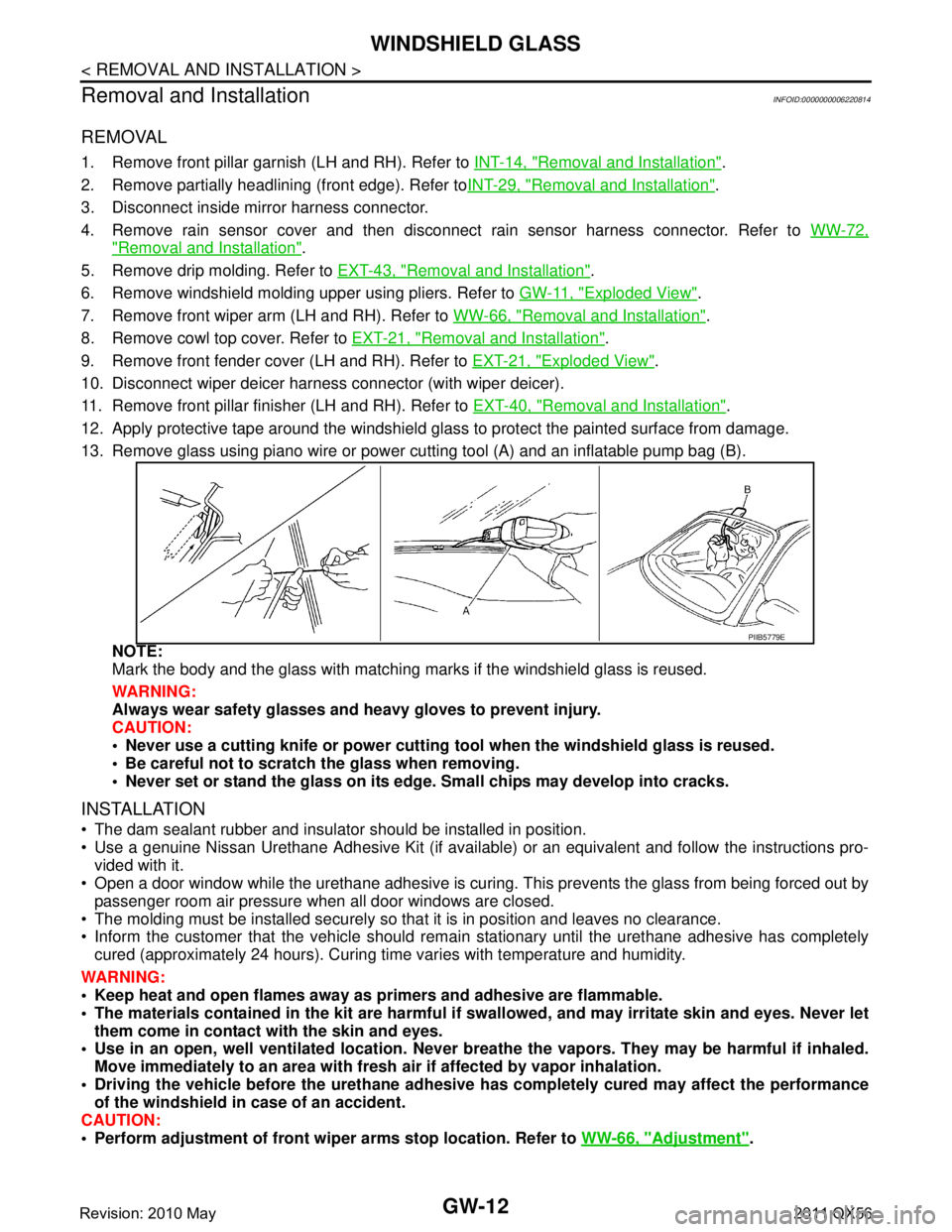
GW-12
< REMOVAL AND INSTALLATION >
WINDSHIELD GLASS
Removal and Installation
INFOID:0000000006220814
REMOVAL
1. Remove front pillar garnish (LH and RH). Refer to INT-14, "Removal and Installation".
2. Remove partially headlining (front edge). Refer to INT-29, "
Removal and Installation".
3. Disconnect inside mirror harness connector.
4. Remove rain sensor cover and then disconnect rain sensor harness connector. Refer to WW-72,
"Removal and Installation".
5. Remove drip molding. Refer to EXT-43, "
Removal and Installation".
6. Remove windshield molding upper using pliers. Refer to GW-11, "
Exploded View".
7. Remove front wiper arm (LH and RH). Refer to WW-66, "
Removal and Installation".
8. Remove cowl top cover. Refer to EXT-21, "
Removal and Installation".
9. Remove front fender cover (LH and RH). Refer to EXT-21, "
Exploded View".
10. Disconnect wiper deicer harness connector (with wiper deicer).
11. Remove front pillar finisher (LH and RH). Refer to EXT-40, "
Removal and Installation".
12. Apply protective tape around the windshield glas s to protect the painted surface from damage.
13. Remove glass using piano wire or power cutting tool (A) and an inflatable pump bag (B).
NOTE:
Mark the body and the glass with matching ma rks if the windshield glass is reused.
WARNING:
Always wear safety glasses and heavy gloves to prevent injury.
CAUTION:
Never use a cutting knife or power cutting tool when the windshield glass is reused.
Be careful not to scratch the glass when removing.
Never set or stand the glass on its edge. Small chips may develop into cracks.
INSTALLATION
The dam sealant rubber and insulator should be installed in position.
Use a genuine Nissan Urethane Adhesive Kit (if available) or an equivalent and follow the instructions pro- vided with it.
Open a door window while the urethane adhesive is curing. This prevents the glass from being forced out by
passenger room air pressure when all door windows are closed.
The molding must be installed securely so that it is in position and leaves no clearance.
Inform the customer that the vehicle should rema in stationary until the urethane adhesive has completely
cured (approximately 24 hours). Curing time varies with temperature and humidity.
WARNING:
Keep heat and open flames away as primers and adhesive are flammable.
The materials contained in the ki t are harmful if swallowed, and may irritate skin and eyes. Never let
them come in contact with the skin and eyes.
Use in an open, well ventilated location. Never br eathe the vapors. They may be harmful if inhaled.
Move immediately to an area with fresh air if affected by vapor inhalation.
Driving the vehicle before the urethane adhesive has completely cured may affect the performance
of the windshield in case of an accident.
CAUTION:
Perform adjustment of front wiper arms stop location. Refer to WW-66, "
Adjustment".
PIIB5779E
Revision: 2010 May2011 QX56
Page 3048 of 5598
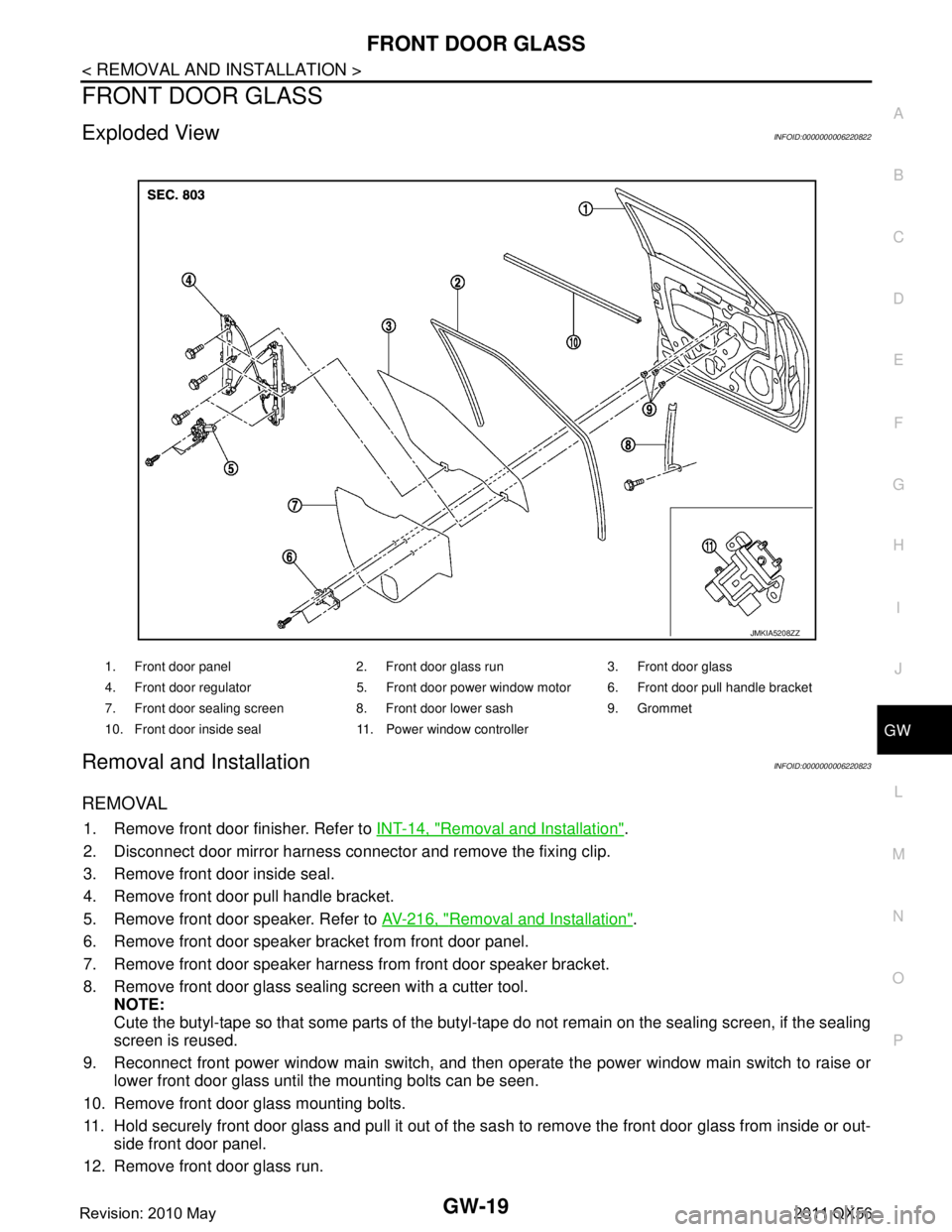
FRONT DOOR GLASSGW-19
< REMOVAL AND INSTALLATION >
C
DE
F
G H
I
J
L
M A
B
GW
N
O P
FRONT DOOR GLASS
Exploded ViewINFOID:0000000006220822
Removal and InstallationINFOID:0000000006220823
REMOVAL
1. Remove front door finisher. Refer to INT-14, "Removal and Installation".
2. Disconnect door mirror harness connector and remove the fixing clip.
3. Remove front door inside seal.
4. Remove front door pull handle bracket.
5. Remove front door speaker. Refer to AV-216, "
Removal and Installation".
6. Remove front door speaker bracket from front door panel.
7. Remove front door speaker harness from front door speaker bracket.
8. Remove front door glass sealing screen with a cutter tool. NOTE:
Cute the butyl-tape so that some parts of the butyl-t ape do not remain on the sealing screen, if the sealing
screen is reused.
9. Reconnect front power window main switch, and then operate the power window main switch to raise or lower front door glass until the mounting bolts can be seen.
10. Remove front door glass mounting bolts.
11. Hold securely front door glass and pull it out of the sa sh to remove the front door glass from inside or out-
side front door panel.
12. Remove front door glass run.
1. Front door panel 2. Front door glass run 3. Front door glass
4. Front door regulator 5. Front door power window motor 6. Front door pull handle bracket
7. Front door sealing screen 8. Front door lower sash 9. Grommet
10. Front door inside seal 11. Power window controller
JMKIA5208ZZ
Revision: 2010 May2011 QX56
Page 3049 of 5598
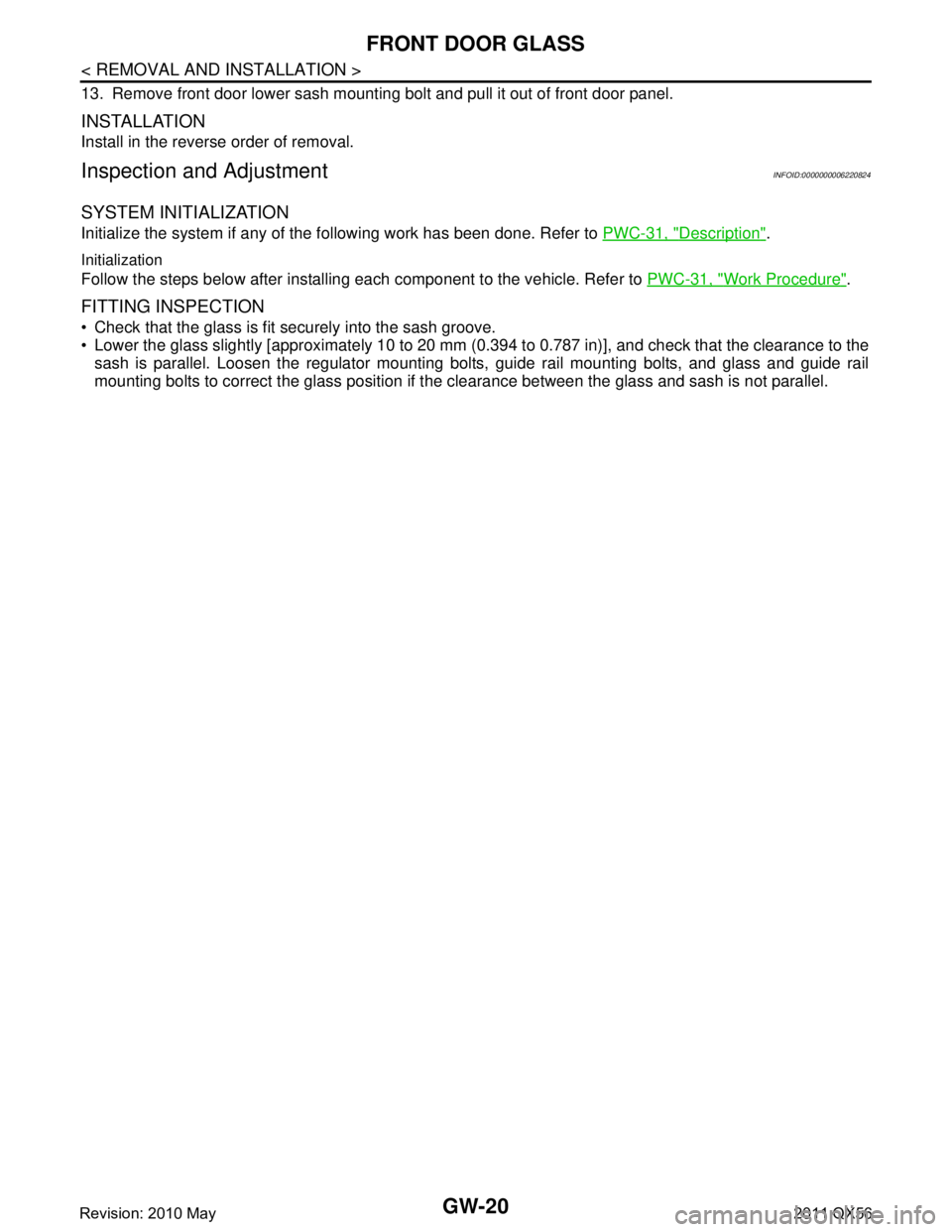
GW-20
< REMOVAL AND INSTALLATION >
FRONT DOOR GLASS
13. Remove front door lower sash mounting bolt and pull it out of front door panel.
INSTALLATION
Install in the reverse order of removal.
Inspection and AdjustmentINFOID:0000000006220824
SYSTEM INITIALIZATION
Initialize the system if any of the following work has been done. Refer to PWC-31, "Description".
Initialization
Follow the steps below after installing each component to the vehicle. Refer to PWC-31, "Work Procedure".
FITTING INSPECTION
Check that the glass is fit securely into the sash groove.
Lower the glass slightly [approximately 10 to 20 mm (0.394 to 0.787 in)], and check that the clearance to the
sash is parallel. Loosen the regulator mounting bolts, guide rail mounting bolts, and glass and guide rail
mounting bolts to correct the glass position if the clearance between the glass and sash is not parallel.
Revision: 2010 May2011 QX56
Page 3051 of 5598

GW-22
< REMOVAL AND INSTALLATION >
FRONT REGULATOR
Inspection and Adjustment
INFOID:0000000006220828
SYSTEM INITIALIZATION
Initialize the system if any of the following work has been done. Refer to PWC-31, "Description".
Initialization
Follow the steps below after installing each component to the vehicle. Refer to PWC-31, "Work Procedure".
FITTING INSPECTION
Check that the glass is fit securely into the sash groove.
Lower the glass slightly [approximately 10 to 20 mm (0.394 to 0.787 in)], and check that the clearance to the
sash is parallel. Loosen the regulator mounting bolts, guide rail mounting bolts, and glass and guide rail
mounting bolts to correct the glass position if the clearance between the glass and sash is not parallel.
Revision: 2010 May2011 QX56
Page 3053 of 5598
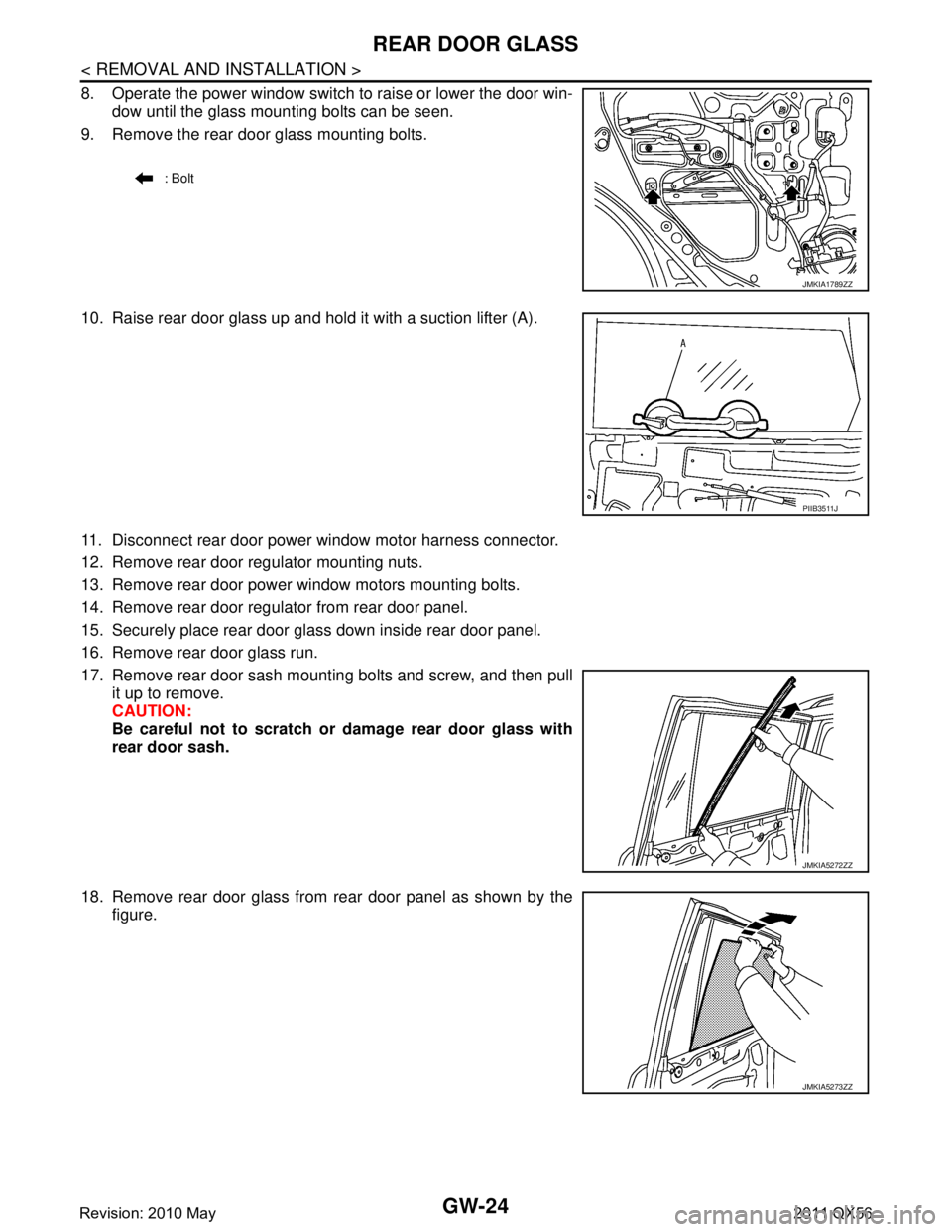
GW-24
< REMOVAL AND INSTALLATION >
REAR DOOR GLASS
8. Operate the power window switch to raise or lower the door win-dow until the glass mounting bolts can be seen.
9. Remove the rear door glass mounting bolts.
10. Raise rear door glass up and hold it with a suction lifter (A).
11. Disconnect rear door power window motor harness connector.
12. Remove rear door regulator mounting nuts.
13. Remove rear door power window motors mounting bolts.
14. Remove rear door regulator from rear door panel.
15. Securely place rear door glass down inside rear door panel.
16. Remove rear door glass run.
17. Remove rear door sash mounting bolts and screw, and then pull it up to remove.
CAUTION:
Be careful not to scratch or damage rear door glass with
rear door sash.
18. Remove rear door glass from rear door panel as shown by the figure.
: Bolt
JMKIA1789ZZ
PIIB3511J
JMKIA5272ZZ
JMKIA5273ZZ
Revision: 2010 May2011 QX56
Page 3054 of 5598
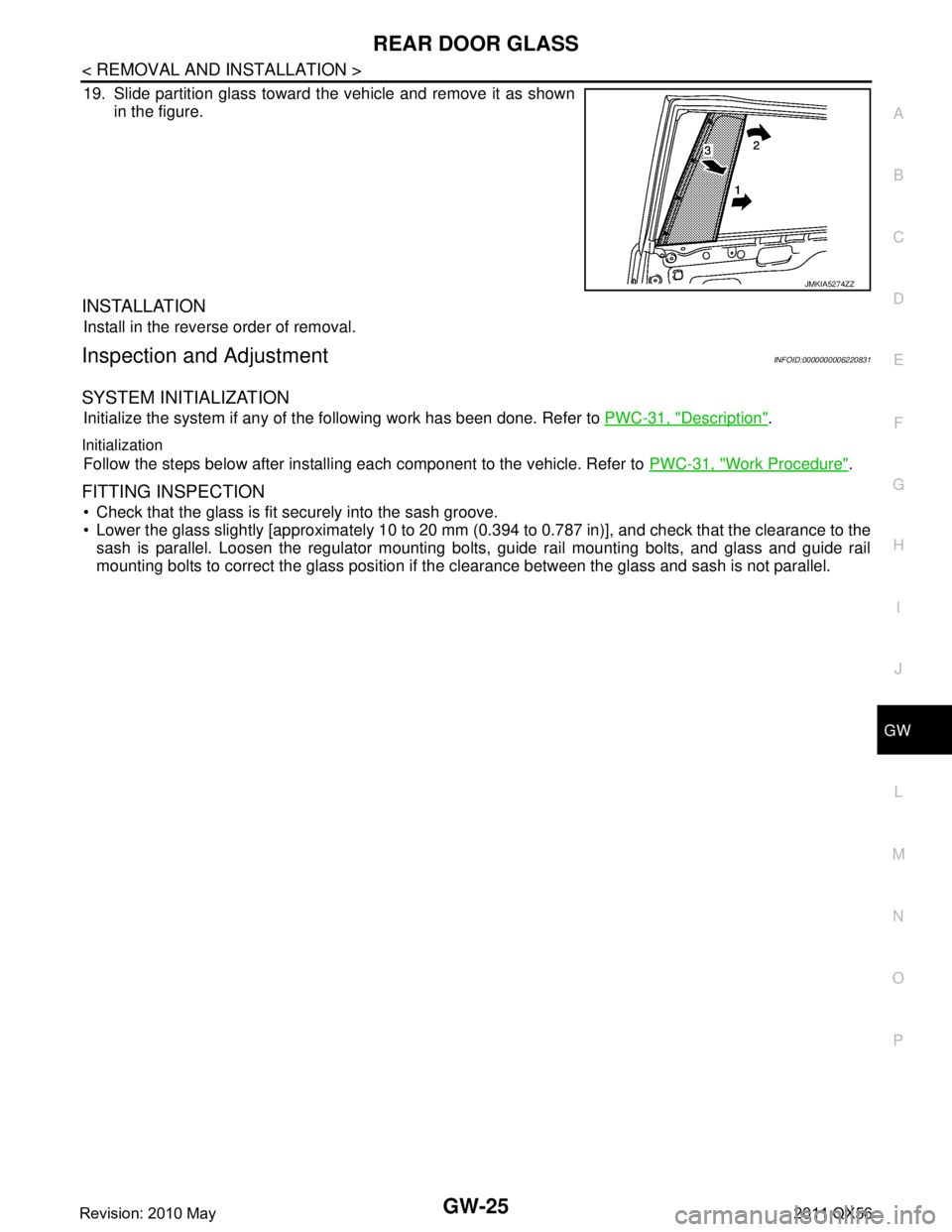
REAR DOOR GLASSGW-25
< REMOVAL AND INSTALLATION >
C
DE
F
G H
I
J
L
M A
B
GW
N
O P
19. Slide partition glass toward the vehicle and remove it as shown in the figure.
INSTALLATION
Install in the reverse order of removal.
Inspection and AdjustmentINFOID:0000000006220831
SYSTEM INITIALIZATION
Initialize the system if any of t he following work has been done. Refer to PWC-31, "Description".
Initialization
Follow the steps below after installing each component to the vehicle. Refer to PWC-31, "Work Procedure".
FITTING INSPECTION
Check that the glass is fit securely into the sash groove.
Lower the glass slightly [approximately 10 to 20 mm (0.394 to 0.787 in)], and check that the clearance to the
sash is parallel. Loosen the regulator mounting bolts, guide rail mounting bolts, and glass and guide rail
mounting bolts to correct the glass position if the clearance between the glass and sash is not parallel.
JMKIA5274ZZ
Revision: 2010 May2011 QX56